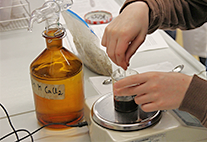“Stick your paws right in!” - Experimenting with soils on the first open-house day
4 February 2015, by Franziska Neigenfind

Photo: UHH/CEN/T. Wasilewski
Moist garden soil, fine sand and gooey loam – on the first open-house day for the Institute of Soil Science, staff from Universität Hamburg explained how and why ...
Moist garden soil, fine sand and gooey loam – on the first open-house day for the Institute of Soil Science, staff from Universität Hamburg explained how and why they research different soils. Several school classes and numerous visitors joined in the event, which the institute organized as part of the United Nations’ “International Year of Soils.”
“Is that clay?” asks a twelve-year-old boy critically, looking eagerly at the soil scientist behind the counter. “It’s silt,” corrects the scientist in a friendly tone. “Here, feel it.” The boy digs his hands into the damp and gritty soil sample – fitting in perfectly with the event’s motto, “Touch and Join In.” The boy belongs to the School and District Garden Club at Hamburg Central School (Stadtteilschule Hamburg-Mitte). Today the group enjoyed a change of scenery, trading the garden for the university. Club leader Georg Friedrich Horn now gathers together the children from grades five through seven; it’s time to go upstairs to the labs.
“I’m very glad to see such a great response to our first open-house day,” says Prof. Eva-Maria Pfeiffer, Director of the institute and Deputy Chair of the Cluster of Excellence CliSAP. Soils, she explains, are both an essential component of the ecological balance and archives of natural, landscape and cultural history that need to be preserved. They represent an important basis for the lives of plants, microorganisms, animals and humans alike. Summing up, Pfeiffer says, “In short: without soils, nothing works.” At the same time, human beings bear a great responsibility when it comes to soils, which is what moved the institute to support the United Nations’ initiative to raise awareness of soils in society.
By now the group has made its way up the stairs, where Angela Maier is waiting to greet them. The exhibit in her lab explores the question: “How much water can my soil hold and store?” The children are then presented with plenty of yellow sand, which they are supposed to sift through a sieve; doing so will tell them what kind of soil it is, which can be recognized by the size of the grains. The sand trickles through a four-stage laboratory sieve: the topmost sieve catches the coarsest sand, while the levels below it collect the medium-grade sand, fine sand, clay and lastly the extremely fine silt. “Look, there’s gold in it!” bursts out one of the girls as Maier shakes out some of the coarsest grains for a closer look on a sheet of white paper. “Unfortunately not,” says Maier with a smile.
Simon Thomsen then coaxes the group to come to the next table, shouting: “Now comes the fun part!” At this station, the children are to feel two types of soil with their hands and decide which of the two is wetter. “Go on, stick your paws right in,” Thomsen says, encouraging a girl standing hesitantly before the jars filled with mud. In this way, the children are introduced to finger sampling – the simplest way to identify soils in the field. To do so, scientists add a bit of water to the soil, then knead it gently to see how it reacts: clay for example is sticky and can be readily formed, while sand has a more floury texture and is harder to form.
The children in the School and District Garden Club, who had brought their own soil samples, now enter the results of their experiments on a certificate. They already have the soil color, humus content and grain size; now it’s time to go up to the fifth floor, where they can measure the pH value and electrical conductivity of their samples. One of the scientists patiently explains the same steps over and over again: label the beaker, weigh it, add ten grams of soil, and add calcium chloride. She then measures the pH value.
Club leader Horn listens especially attentively as the results of the experiments are announced, because at the school garden the children have the chance to do research of their own: for some samples, they added bio-coal, basalt or powdered clay as fertilizer, while they left others untouched. The goal was to arrive at “soils that are healthy and full of life,” as Horn explains. “The idea is for the children to learn that nutrients are the key to healthy soils. We want to increase the number of microorganisms, which increases soil fertility.” The children’s day at the institute is nearly over, and the waffles they had during the break were tasty. But the best part was sifting the soil, according to twelve-year-old Jenny.
The Institute of Soil Science is a member of the Center for Earth System Research and Sustainability (CEN) at Universität Hamburg.
- Join-in programs in 2015 at the Institute (only in German)
- Schedule for the open-house day on January 28, 2015 (PDF, German)
- International Year of Soils (only in German)
